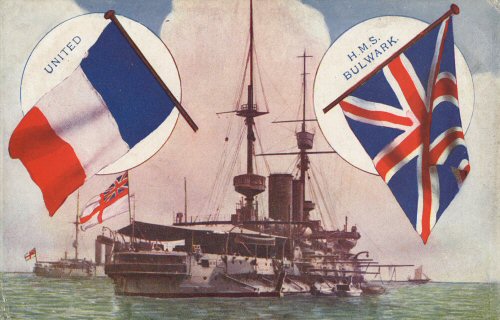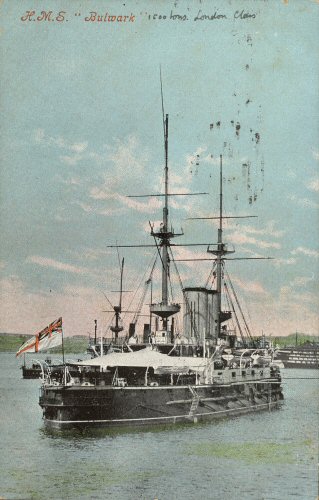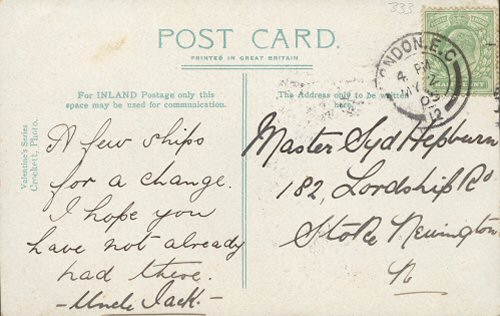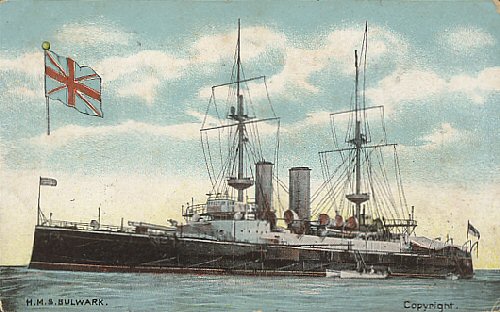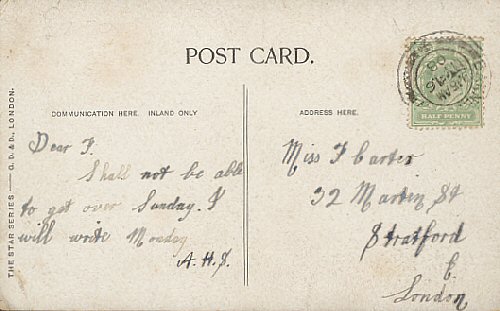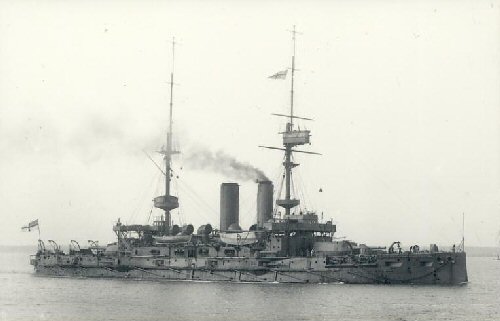
Sunk by accidental explosion. 26 November 1914
Built Devonport Dockyard, laid down March 1899, completed March 1902, cost £1,056,816.
Size:
Length 411 feet waterline 431 feet 9 inches overall, beam 75 feet, draught 27 feet 5 inches, displacement 15,366 load 15,955 tons deep.
Propulsion:
2 shaft Triple Expansion, 15,000 ihp, 18kts
Trials:
Bulwark 15,355 ihp = 18.09 knots
Armour:
9in belt, 12in barbettes, 10in gun houses, 2.5-1in decks
Armament:
4 x 12in 40 cal BL (2 x 2), 12 x 6in QF (12 x 1), 16 x 12pounder QF (16 x 1), 6 x 3pounder (6 x 1), 4 x 18in TT
World War 1 Service:
5th Battle Squadron Channel Fleet.
26 November 1914 sunk by accidental explosion at Sheerness
The Accidental Death of HMS Bulwark (1914)
On the afternoon of Thursday, November 26th, 1914, Winston Churchill made the following statement to the House of Commons :
"I regret to say I have some bad news for the house. The Bulwark battleship, which was lying in Sheerness this morning, blew up at 7.35 o'clock. The Vice and Rear Admiral, who were present, have reported their conviction that it was an internal magazine explosion which rent the ship asunder. There was apparently no upheaval in the water, and the ship had entirely disappeared when the smoke had cleared away. An inquiry will be held tomorrow which may possibly throw more light on the occurrence. The loss of the ship does not sensibly affect the military position, but I regret to say the loss of life is very severe. Only 12 men are saved. All the officers and the rest of the crew, who, I suppose, amounted to between 700 and 800, have perished. I think the House would wish me to express on their behalf the deep sorrow with which the House heard the news, and their sympathy with those who have lost their relatives and friends."
HMS Bulwark, a battleship of 15,000 tons, was moored to No.17 buoy in Kethole Reach on the River Medway, almost opposite the town of Sheerness, Isle of Sheppy, Kent. It was one of the ships forming the 5th Battle Squadron. She had been moored there for some days, and many of her crew had been given leave the previous day. They had returned to the Bulwark at 7 o'clock that morning and the full complement was onboard. The usual ship's routine was taking place. Officers and men were having breakfast in the mess below deck, other were going about their normal duties. A band was practising while some men were engaged in drill. The disaster struck.
A roaring and rumbling sound was heard and a huge sheet of flame and debris shot upwards. The ship lifted out of the water and fell back. There was a thick cloud of grey smoke and further explosions. When the smoke eventually cleared, the Bulwark had sunk without trace.
The scene was described by an eye witness, who was onboard a ship nearby, to a local newspaper:
"I was at breakfast when I heard an explosion, and I went on deck. My first impression was that the report was produced by the firing of a salute by one of the ships, but the noise was quite exceptional. When I got on deck I soon saw that something awful had happened. The water and sky were obscured by dense volumes of smoke. We were at once ordered to the scene of the disaster to render what assistance we could. At first we could see nothing, but when the smoke cleared a bit we were horrified to find the battleship Bulwark had gone. She seemed to have entirely vanished from sight, but a little later we detected a portion of the huge vessel showing about 4ft above water. We kept a vigilant look-out for the unfortunate crew, but only saw two men."
The explosion was heard in Whitstable, 20 miles away, and in Southend where the pier was shaken by the explosion but not damaged. Ships anchored off Southend holding German civilian prisoners also reported hearing the explosion. Residents in Westcliffe-on-Sea claimed they saw "a dense volume of greenish smoke which lasted for about ten minutes". The nearby areas of Sheerness and Rainham took the brunt of the blast with reports of damage to property being made. Rumour began to run wild amongst the residents. Some claimed it was the expected and feared Zeppelin raids commencing, others said that a periscope had been sighted and the Bulwark had been sunk by a submarine. Others thought that espionage had taken place and were on the look out for suspicious people in town. All these rumours were later discounted.
Boats of all kinds were launched from the nearby ships and shore to pick up survivors and the dead. Work was hampered by the amount of debris which included hammocks, furniture, boxes and hundreds of mutilated bodies. Fragments of personal items showered down in the streets of Sheerness. Initially 14 men survived the disaster, but some died later from their injuries. One of the survivors, an able seaman, had a miraculous escape. He said he was on the deck of the Bulwark when the explosion occurred. He was blown into the air, fell clear of the debris and managed to swim to wreckage and keep himself afloat until he was rescued. His injuries were slight.
None of the Bulwark's officers survived; although 11 of them were recovered for eventual burial.
Rescue work continued during the remainder of the week and on Saturday November 28th, an inquest was opened at the Royal Naval Hospital in Chatham. The Admiralty was represented by a local solicitor Mr. E. L. Baker. The Coroner informed the jury that the proceedings were to be kept to evidence concerning the identification of bodies, and that on occasions he may have to re-open the inquest for subsequent identification. By this time only 30 bodies had been recovered and 14 could be identified. These bodies were identified by Cooks Mate William Frederick Cooper who was on sick leave on shore at the time of the explosion. The Chief Surgeon at the Naval Hospital, Percy Minett, gave evidence that the cause of death to all of the 30 men was burns. He also stated that two of the original survivors, Private Gilbert Guy and Able Seaman Walter Crow had died the previous night from their injuries without making any statement.
The Coroner then adjourned the inquest until Wednesday, December 16th when it was hoped the results of the Admiralty Court of Inquiry would be available.
On Monday, November 30th, the funerals of 21 of the victims took place in the Naval Burial Ground at Woodlands Cemetery, Gillingham. The funeral procession left the Naval Hospital headed by the Royal Marines Band (Chatham Division). The bodies were conveyed in five lorries. Following the bodies were private mourners and a naval party. All along the route, signs of mourning were apparent and flags were flown at half mast. The funeral party was met at the cemetery by Read Admiral E. F. A. Gaunt and Flag Captain P. H. Colomb representing the Admiralty; the Commander-in-Chief Nore, Colonel A. E. Marchant represented the Royal Marines. Representatives from the local councils were also in attendance showing how the local population felt the horror of this incident.
The service was conducted by the Rev. R. S. Hartley (Chaplain RN Hospital) and the Rev. F. G. L. Cruce (Chaplin RN Barracks, Chatham). Following the interment of the bodies, the Royal Marine Buglers sounded the Last Post to close the ceremony. On Monday, December 1st, the burials of Captain H. C. Morton RM and Lt. Cdr. C. M. Queripel took place at St. Nicholas Cemetery, Rochester and Woodlands Cemetery, Gillingham respectively.
The Bulwark inquest was re-opened on December 2nd to identify and establish the cause of death on Stoker Anthony Eames and Able Seaman James Anderson, both original survivors and Reginald Overton a boy. Lt. Cdr. Queripel had been identified at a previous re-opening of the inquest.
On Wednesday, December 16th, the Kent Coroner again re-opened the inquest at Gillingham. Among those present were Rear-Admiral Ernest Frederick Augustus Gaunt (Commodore RN Barracks, Chatham) who was also the President of the Admiralty Court of Inquiry. Surgeon-General A. J. J. Johnston and Mr. G. W. Ricketts were representing the Admiralty. Major Cooper Key, Inspector of Explosives, Home Office, was in attendance to assist the Coroner. Thus the scene was set for the inquest into the tragic loss of HMS Bulwark and her crew.
The first witness was Lt. Benjamin George Carroll, who was assistant coaling officer at Sheerness. He stated that he was passing down the River Medway on the day in question and saw the Bulwark lying in Kethole Reach. He was looking at a signal she was flying, indicating the amount of coal onboard, when he saw a spurt of flame abaft the after barbette turret. Then the flame seemed to rush towards the after funnel and the whole interior of the ship blew into the air and everything seemed on fire. He added that the water was calm and there was no tide and saw no disturbances in the water. He finished his evidence by stating that he rendered what assistance he could and was convinced it was an internal explosion that he had seen.
The deposition of Sgt. John Albert Budd, RM, who was still in hospital suffering from burns and a fractured leg, was read out to the court. In his deposition he said that he was serving on the Bulwark at the time of the explosion and had been with her since mobilization. At 7.30 he was finishing his breakfast on the portside second mess deck, when he saw a sudden flash aft. He turned and then the deck seemed to open up under him and he fell down. He recalled coming to the surface of the water and saw the Bulwark had disappeared. He had heard no explosion.
Finally Rear-Admiral Gaunt took the stand and gave his evidence. He stated that exhaustive and scientific investigations had bee completed. There was no evidence to suggest that the explosion was external; and that everything pointed towards the explosion being internal. There was no evidence of treachery or of loose cordite. He said that loose cartridges in the cross ammunition passages had been found.
The Coroner asked if this had any relation to the cause of the explosion. Rear-Admiral Gaunt replied "No". The Coroner pressed the point "There must have been ignition somewhere ?" The Rear-Admiral replied as follows : "All the evidence we had was that the explosion occurred. After that there was no proof of the actual cause. There were many possible causes, but no direct evidence and there have been many theories which are untrue." The jury were not satisfied with this explanation, even after a Commander Wilton confirmed that every cartridge onboard was traced and that no evidence of loose cordite was found. A juror asked the question again, "We should like to know how ignition occurred ?" The Coroner replied, "That is precisely what we cannot solve !"
The Coroner, clearly not quite satisfied with the evidence, summed up the findings. He said it was impossible to discover exactly how the ignition was caused. The theory of external explosion could be discounted. If the jury were prepared to endorse the views placed before them, then their duty would be very simple. A verdict of accidental death was returned and the inquiry on the crew of HMS Bulwark was closed.
During January 1915 many more bodies of the Bulwark's crew were washed up on the Kent shoreline. Many were identified some were not. Woodlands Cemetery in Gillingham has 82 graves to unknown ratings from World War I, they all contain the bodies of crew members from Bulwark. Twelve lie in individual graves, the 70 are in a large communal grave with those from another disaster in Sheerness the following year. Of those identified, 67 are buried in Woodlands.
Article written by Richard Stacpoole-Ryding/Published by Medal News© September 1991
